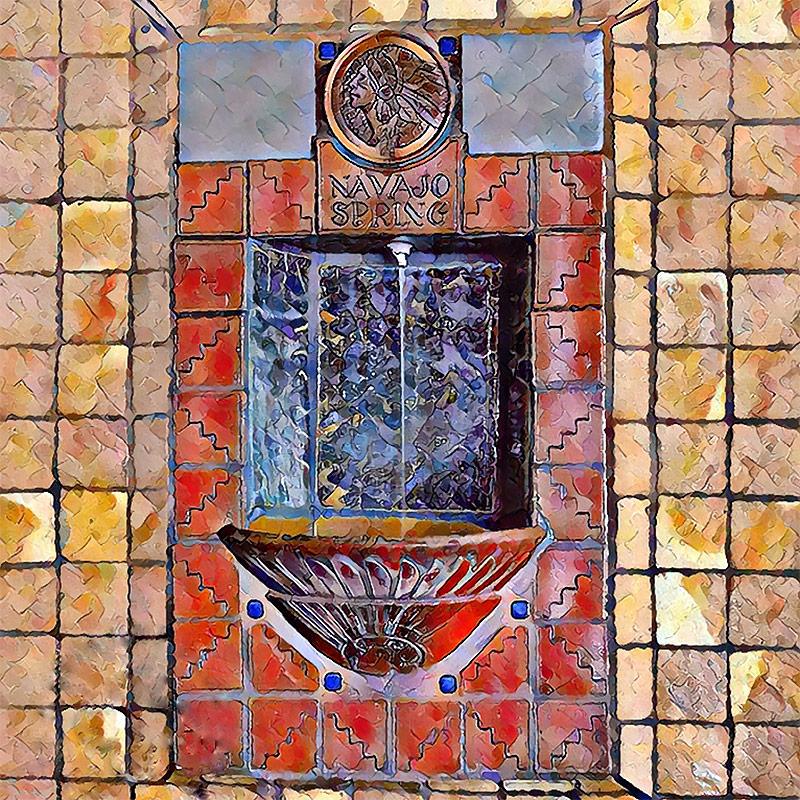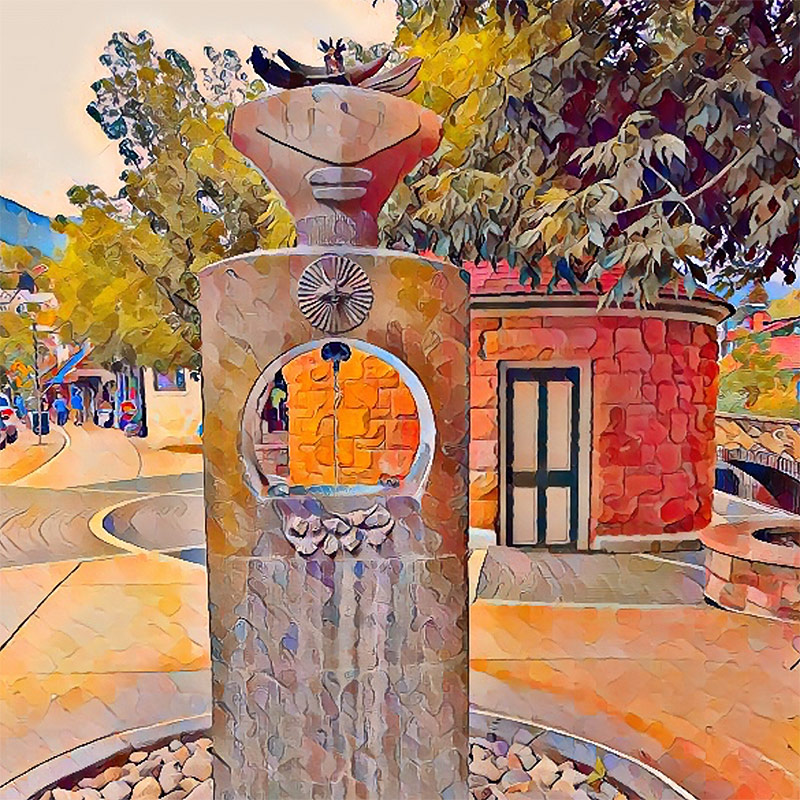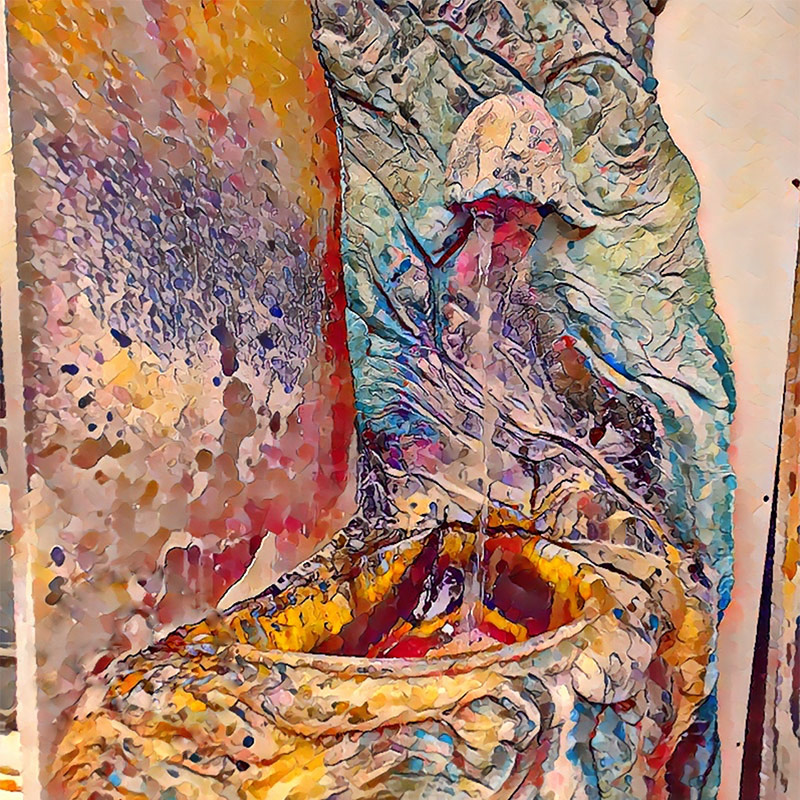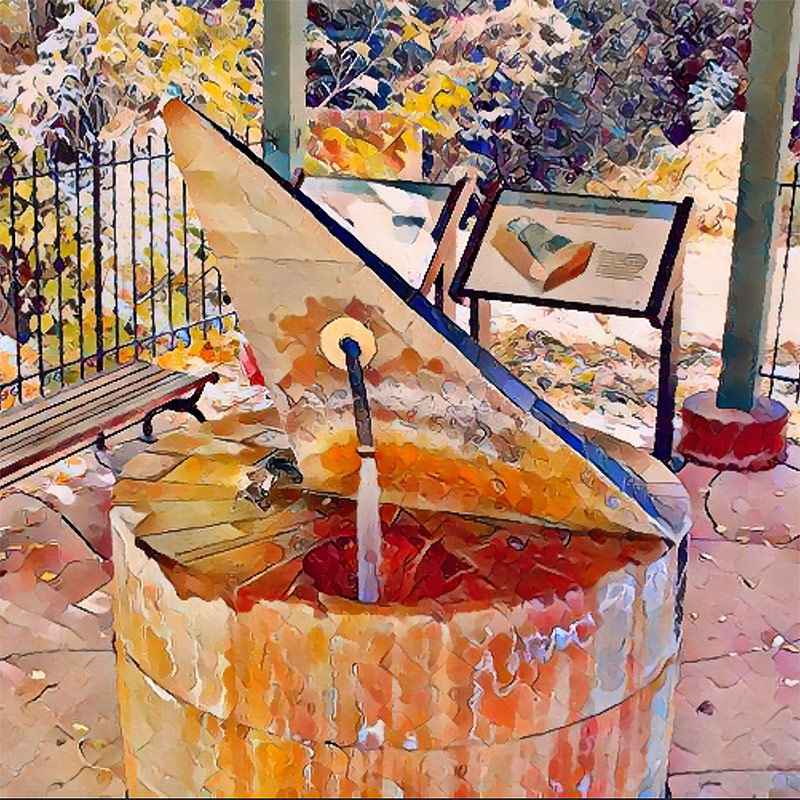Our Water
Manitou Springs
est. 1872
Click for Spring Info

A beloved Manitou landmark, 7 Minute Spring became a part of the town’s history and character in 1909, when it was drilled near the site of what was then the Manitou House Hotel. The newly-breached spring’s natural effervescence, known to the area’s First People as the Breath of the Great Spirit, produced a geyser every seven minutes.
It is this spring, fed by the karst aquifer deep in the living rock of the rugged Tava Mountain foothills, that lends us the mineral-rich water that flows into the cedar tubs at SunWater.

Mineral water from Shoshone Spring may contain the greatest amount of deep-seated water rising from the aquifer system. It has some of the highest amounts of mineral content, and it’s the warmest with a temperature just over 70 degrees Fahrenheit. The chalk-white deposit left by the mineral water on its font is travertine, derived from dissolved limestone and dolomite layered in the underground karst aquifer.

Bubbling up from the depths of Earth, minerals in this natural soda spring created a large basin or pool, making this a popular stopping place for American Indian tribes and early explorers. One of the earliest known photographs of Manitou Springs is of Navajo Spring: the water ran from the basin into Fountain Creek forming a large deposit, or flowstone, of minerals. The flowstone still exists beneath the world famous Penny Arcade and Patsy’s Candies.

During the 1870s, Cheyenne Spring was part of the then-larger Soda Springs Park which encompassed the springs of Navajo, Cheyenne, Shoshone, and Manitou. Twenty years later, the current spring-house was built over the naturally-carbonated, artesian soda spring by the Manitou Mineral Water Company.

Like many of Manitou’s springs, Wheeler Spring used to erupt at regular intervals when the carbonation in the water built up enough pressure to force it from the well. Restored in 1989 by the City of Manitou Springs and the Mineral Springs Foundation with a font designed by Randy Bowen, the water is now regulated to a steady flow to allow for easy filling of containers.

After the demise of the streetcar trollies, a new mineral spring well was drilled to bring distinctive character to Stratton’s “Loop” properties at the southeast corner of Manitou and Ruxton Avenues. On February 21, 1936, at a depth of 283 feet, sparkling soda water was struck flowing at 25 gallons per minute. Today, Stratton Spring stands as one of Manitou’s iconic mineral spring assets along its downtown corridor, ensuring Winfield Scott Stratton’s legacy.

Restored in 1994 by the Mineral Springs Foundation and its private owner, Kerstin Ericsson, who also designed the unique font. Twin is a favorite among many who enjoy the natural taste of this strong-flowing spring, and it’s also popular for making mineral-water lemonade.

George Fredrick Augustus Ruxton explored the American Southwest in the frontier days, representing British diplomatic and commercial interests. In the Spring of 1847, he passed through Manitou Springs and wrote extensively about his adventures in the foothills of Pikes Peak. Ruxton Creek, flowing out of Englemann Canyon and one of three major drainage basins converging in Manitou Springs, was named in honor of the Englishman.

The land upon which Manitou Springs was founded had long been a sacred cultural crossroads for the Anasazi, Kiowa, Cheyenne, Ute and Arapaho people. They gathered here near the mineral springs, whose natural carbonation they called The Breath of The Great Spirit.
They believed these waters carried great power to heal and cleanse.
Today the community is one of the most eclectic and charming places in the country, full of art, music, and spiritual seeking. Manitou draws visitors from all over the world, many of whom still come here to sit at the foot of Tava Mountain and experience the power of these waters.
7 Minute Spring Mineral Content

Calcium (Ca) 303 mg/L
Calcium – the mineral used most by the body – is a critical building block for bone and tooth formation. It regulates the rhythm of the heartbeat and is necessary for heart function, blood coagulation, and muscle contraction. Calcium also helps with menstrual and menopause issues, helps to prevent osteoporosis, and promotes stronger tooth enamel and bones.

Chloride (Cl) 96.4 mg/L
Chloride is an electrolyte that works with potassium and sodium to keep the fluid balance in and out of the body’s cells. It helps maintain proper blood volume and pressure, and is important for proper function of the liver, joints, and tendons.

Fluoride (F) 0.64 mg/L
Fluoride is essential in bone and tooth formation and promotes the hardening of tooth enamel. Fluoride stimulates new bone formation throughout the life cycle, offering some protection from developing osteoporosis. It is beneficial for the overall health of bones, teeth, blood, skin, hair, and nails.

Iron (Fe) 0.54 mg/L
Iron is the oxygen-carrying component of the blood. Vitamin C greatly helps to improve iron absorption. Iron deficiency can lead to anemia, which causes lethargy, poor concentration, pale skin, and shortness of breath.

Lithium (Li) 0.28 mg/L
Lithium has been used since the 1960s for the treatment of mood disorders. It is active in promoting the formation of new brain cells, protects against neurodegenerative diseases, and is known for its calming effects.

Magnesium (Mg) 82.6 mg/L
Hundreds of enzymes require magnesium ions to function properly. Magnesium and calcium must be in proper proportion to perform their respective functions in the body. Magnesium also has had some success in treating migraines, asthma, and diabetes.

Potassium (K) 19.5 mg/L
Potassium is important in brain and nerve function. It is the third most abundant mineral in the body and assists in controlling convulsions, migraines, allergies, and alcoholism. Potassium also promotes faster healing of burns, cuts, and bruises.

Silica (SiO₂) 22 mg/L
Silica is responsible for the growth, strength, and management of many connective tissues. It is a trace mineral that promotes the health of hair, skin, nails, and arteries.

Sodium (Na) 159 mg/L
Sodium is an electrolyte that plays a critical role in maintaining the balance of positive and negative ions in body fluids. It helps maintain blood pressure levels, assists in controlling mental apathy, and is involved in nerve transmission and muscle contraction.

Sulfate (SO₄²-) 96.7 mg/L
Sulfate promotes a laxative effect and a decrease in gastrointestinal retention of food at certain concentrations.

Zinc (Zn) 0.34 mg/L
Zinc is an important antioxidant that supports the health of the immune system. It regulates blood sugar, blood pressure, heart rate, and cholesterol levels. Zinc has been used to treat Alzheimer’s disease, arthritis, arteriosclerosis, and infertility.
Visit the Mineral Springs Foundation page for more information on each of the mineral springs in Manitou.

